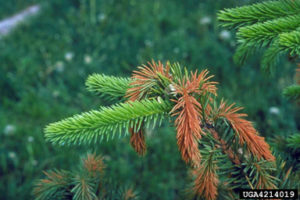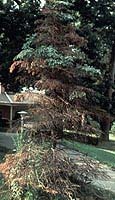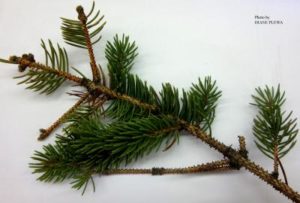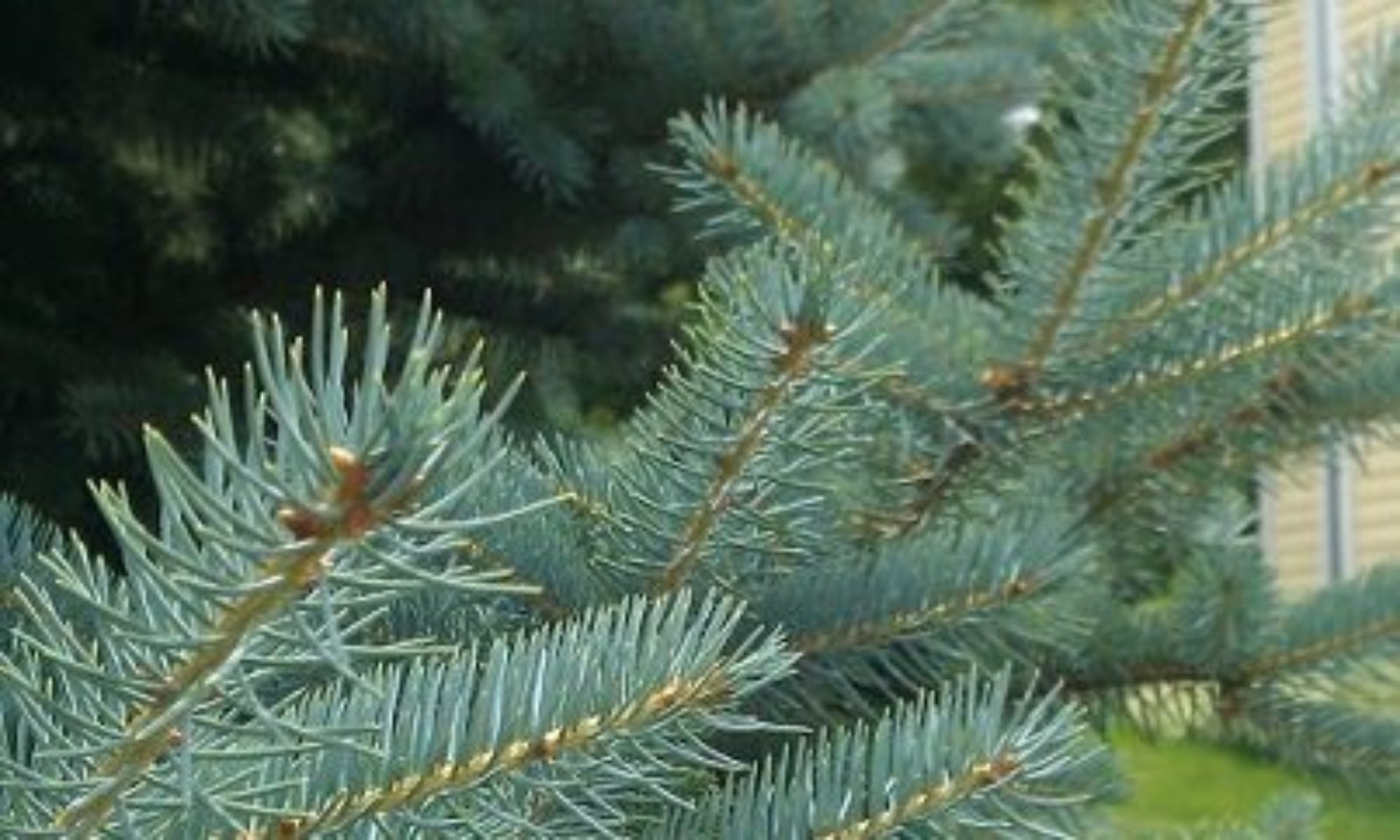
What is going on with Spruce trees?? Colorado Spruce trees are not native to Illinois, and are really having a tough time lately with the changing environment we’ve had over the last decade! Other varieties of Spruce trees are having a hard time as well.
We just received an update from the University of Illinois Extension service that there are several issues going on at this time with Spruce trees in the area. Below is a list of diseases that they are seeing at this time of year, and the accompanying symptoms that go along with them.
Abiotic Damage
Abiotic Damage is basically just environmental factors, such as too much water, pest damage, frost cracks, frost damage to needles, salt damage, drought stress, and in some cases all of the above combined! The tree will shows signs of distress such as oozing sap through cracks, needles browning, last year’s growth falling from tree, or drooping limbs.
In order to help your trees to better recover, we recommend giving them a good quality fertilizer- organic is always best- to help alleviate some of the stress that the tree has endured.
Stigmina Needle Cast (Stigmina lautii)
Stigmina Needle Cast is a fungal disease of Spruces where the 2nd and 3rd previous year’s growth will turn a purplish color and drop off or die. The current year’s growth is typically not affected. This disease will begin at the bottom of the tree and work upwards.
Not much is known about this disease, including it’s life cycle. It exhibits symptoms similar to Rhizosphaera Needle Cast, but has a different fruiting body. Needles may look like this:
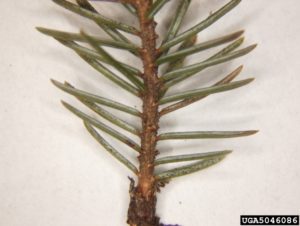
stigmina lautii fruiting bodies on Spruce needles
Photo courtesy of Joseph OBrien, USDA Forest Service, Bugwood.org
According to the University of Illinois extension, this disease has a medium rate of frequency and severity. If your Spruce is diagnosed with this disease, you may be able to help alleviate some symptoms by properly pruning diseased brances, and removing them from the site. You should also rake up any needles under the tree that may have the fruiting bodies on them, and remove them from the site as well. Once again, organic fertilizing is always a great idea to help your trees recover from stress and keep the new growth healthy.
Rhizosphaera Needle Cast (Rhizosphaera kalkhoffii)
Rhizosphaera Needle Cast is another common disease of Spruce trees where the older needles will turn a yellowish brown in the late summer and by Spring of the following year turn purplish brown and fall off. With this disease, the fruiting bodies will appear as smooth round ball shapes in rows on the needles. This will be the indicator between Rhizosphaera and Stigmina Needle Cast.
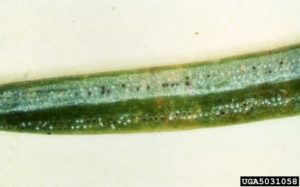
Rhizosphaera Needlecast Fruiting bodies
Photo Courtesy of Joseph OBrien, USDA Forest Service, Bugwood.org
According to UofI extension, the best management for Rhizosphaera Needle Cast is to
“Plant spruces that are considered resistant. Provide good air circulation. Avoid overhead watering and watering at night. Get positive identification of the disease. There are other non-infectious diseases that may mimic needle cast symptoms. Remove all infected needles and destroy. Chemical controls are effective if the disease is not too severe. Because this fungus requires twelve to eighteen months for symptom expression, at least two years of fungicide sprays are usually required. To reduce the risk of reinfection of older trees, continued treatments may be required.” http://extension.illinois.edu/focus/index.cfm?problem=rhizosphaera-needle-cast
Contact your local Arborist to diagnose your tree and to see if treatment can and should be done.
Cytospora Canker
For a detailed description of this disease that most commonly affects Colorado Spruce trees, visit our post at: Cytospora Canker on Spruce Trees
Sudden Needle Drop
Sudden Needle Drop or SNEED can be identified by the yellowing or browning of older needles throughout the canopy of the tree which will fall off by Autumn and leave the healthy newer needles behind.
SNEED is thought to be caused by tree stress, and environmental factors such as poor soil which enables the fungus Setomelanomma holmii to take up residence in the Spruce tree and further weaken the tree. The fungus itself is not thought to be the cause of SNEED, it just typically presents with the other symptoms. The University of Il Extension describes the fungus as forming ‘small, black, round spore-producing structures on the stems and bud scales of affected spruce.’ These would typically be seen through a microscope. Again, the fungus forms at the base of the needles and on the stems themselves.
Fungicide treatments can be used to manage the fungus on Spruce trees affected with SNEED, and of course, Organic Fertilizers are recommended to help it recover from any environmental stresses. You should also have an Arborist examine the tree to see why it is stressed to begin with, and come up with a plant health care plan to help recover.
Spider Mites (Oligonychus ununguis)
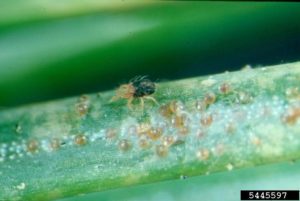
Adult spruce spider mite with eggs on spruce needle
Image courtesy of Ward Strong, BC Ministry of Forests, Bugwood.org
According to James Schuster, retired Extension Educator, Horticulture & Plant Pathology, and reviewed by Philip L. Nixon, Extension Specialist-Entomology, Department of Crop Sciences, University of Illinois at Urbana-Champaign:
The spruce spider mite (Oligonychus ununguis) is a cool weather mite. Hot dry weather causes this “insect relative” (an adult mite has eight legs so it’s not a true insect which has six legs) to cease feeding and to disappear till fall. Spruce spider mite can cause severe feeding damage to evergreens when they build to a high population. Spider mites are a piercing sucking type insect relative. They feed on chlorophyll in leaf cells. The feeding empties the cell of the green chlorophyll. Thus a tiny cream to yellowish spot occurs. The feeding damage is called stippling. Severe stippling/feeding damage can cause the needle or scale (leaves) of the evergreen to die. Spruce spider mites often produce a single silk thread (similar to a regular spider).
Often an additional population of predatory mites may overlap and feed on the spruce spider mites. When benificials are numerous, no insecticide or miticide should be used. These pesticides will kill the good mites easier than the harmful mites. In addition, the good mites tend to eat more of the bad mites than the pesticides often kill. Predatory mites move faster than spider mites. If both types are present at the same time, you can separate the two by their speed of movement. However, if only one of the two is present, it becomes more difficult to determine if the mite is beneficial or the harmful spruce mites. Predatory mites tend to be reddish and when squashed, leave a red stain. The spruce mite tends to be dark green to dark brown. When squashed they leave a greenish stain.
Management
Check for mites by holding a piece of white paper under a branch and tapping the branch against the paper. If small dust/ like particles are seen moving around, check the moving speed or their color when squashed. If only a small number of spruce mites are found, you may not need to do anything. If, however, a high population of only spruce spider mites is found, a miticide control is usually recommended. If there are numerous beneficial mites present at the same time as the spruce mites, a chemical control is not suggested.
Once again, if you suspect your trees are infected, contact your local Arborist to diagnose the tree. They will let you know whether a miticide should be applied, and when it should be done. Fertilizing a tree that is infested with Spider Mites is not recommended, as it may increase the population. Once the mite population has been reduced, a fertilizer can be applied to help the tree recover.
If you would like more information, or live locally to McHenry County, IL please contact us using the following form:
If you would like to subscribe to our newsletter to stay on top of Plant Health Care topics and specials, complete the following form:
Information for this article was obtained through the University of Illinois Extension services May 2017.


